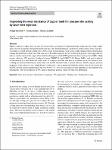Item Infomation
Full metadata record
| DC Field | Value | Language |
|---|---|---|
| dc.contributor.author | Philipp, Warneke | - |
| dc.contributor.author | Annika, Bohlen | - |
| dc.contributor.author | Thomas, Seefeld | - |
| dc.date.accessioned | 2023-05-24T01:17:32Z | - |
| dc.date.available | 2023-05-24T01:17:32Z | - |
| dc.date.issued | 2023 | - |
| dc.identifier.uri | https://link.springer.com/article/10.1007/s11740-022-01164-5 | - |
| dc.identifier.uri | https://dlib.phenikaa-uni.edu.vn/handle/PNK/8495 | - |
| dc.description | CC BY | vi |
| dc.description.abstract | Highly conductive copper alloys are used for various tools in casting and welding technology. In pressure die casting, copper alloys are used for pistons pressing the metal melt into a die. The high thermal conductivity of these alloys allows short process times as a result of high cooling rates. Due to a poor wear resistance, wear occurs on the running surface of the pistons causing the metal melt to spurt out of the shot sleeve. In order to improve the service life of the pistons, a new approach was taken: a reinforcement of the copper alloys with fused tungsten carbide (FTC) particles by laser melt injection (LMI) at high process velocities. FTC provides a hardness between 2700 HV 0.1 and 3500 HV 0.1. During LMI, a melt pool is induced on the substrate by a laser beam and a filler material is injected into this melt pool by a powder nozzle. In contrast to laser cladding, the filler material remains in the solid state and the substrate works as matrix material. | vi |
| dc.language.iso | en | vi |
| dc.publisher | Springer | vi |
| dc.subject | FTC | vi |
| dc.subject | LMI | vi |
| dc.title | Improving the wear resistance of copper tools for pressure die casting by laser melt injection | vi |
| dc.type | Book | vi |
| Appears in Collections | ||
| OER - Kỹ thuật điện; Điện tử - Viễn thông | ||
Files in This Item:

